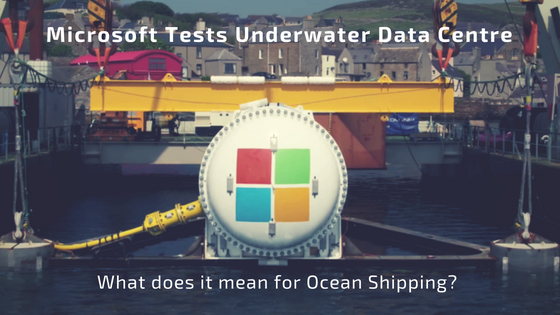Microsoft Tests Underwater Data Centre
There is no limit as to how fast technology is advancing day by day and the marine industry is not lagging behind. Nowadays, companies are opening their data center in the some of the strangest places on Earth. Just like, Microsoft has launched its new underwater data system off the coast of Scotland and it has given rise to a lot of future possibilities in this field.
This particular data center is called the ‘Project Natick’ and it is an eco-friendly, environmentally sustainable data center unit that is bound to expand in the future. Reportedly, the Project Natick is placed underwater at 100 feet below the North Sea in close proximity to the Orkney Islands in the United Kingdom.
The Orkney Islands is renowned for generating 100% percent of the energy from natural sources like solar, tidal and wind. This implies that the Microsoft data center is not harming the surrounding environment with toxic carbon emissions because it is being powered by an undersea cable. Even though it is currently owned by the Scottish Government, the data center is brilliantly designed to accommodate into standard shipping containers and be transported to any desired destination. The company has long-term plans of putting a sale tag on this pre-packaged unit that completely runs on renewable energy.
The Project Natick is composed of a 40-foot container that includes an approximate of 864 servers. The main advantage of installing an underwater data center below is the low cooling cost since the ocean is naturally cool at a certain depth. In an attempt to evaluate the pilot project, the company is now focussed on operating the data center for a year before reaching any conclusion. For the time being, the servers will undergo a battery of tests to assess the worth of its power consumption, temperature, humidity level and noise creation.
Microsoft will also allow some selected customers to access the data center. If all goes well, the company will then provide access to all its customers to use the servers and run their own computations too. Microsoft is hoping to increase the lifespan of the data center and utilize its benefits for at least 20 years. Following the estimated lifespan, the unit will be recovered and recycled for further usage.
Currently, the company is contemplating the linking of the data center to a tidal energy system that will produce limitless electricity in the future. After careful planning and keeping in mind the anticipated lifespan of the computers in the unit, it has been decided that a deployment cycle of 5 years will be implemented. At the completion of every 5 years, the data center unit will be retrieved and reloaded with new machines.
Microsoft has not yet revealed the cost of the Project Natick but it is bound to be much cheaper than the ordinary, land-based centers. The reason behind this is the simple infrastructure and minimal requirements, which does not need high maintenance or high expenditure.
This project has been inspired by submarine technology. The brains behind this thought that if a submarine could travel through water, with all that technology, why can’t a data center? Water and technology are contradictory elements that do not go well together, but this does seem to work.
Submarines, however, seem to be posing as a security threat, as most of them travel undetected. Relatively cheap and virtually silent, diesel-electric submarines are quickly becoming one of the biggest threats to naval operations and a $1.8 trillion commercial shipping industry.
However, Leidos (a company that integrates information technology with engineering and science) developed an unarmed, unmanned vessel to shadow diesel-electric subs for months across thousands of miles of ocean and chase them out of strategic waters. The ships travel using data and patterns, allowing them to travel smoothly, without any hiccups. The ACTUV (the vehicle) is "smart", using collected data and sophisticated logic to identify other vessels, determine the intent of the craft it is tracking, and adjust its mission based on weather, geography, and external updates.
This is quite similar to the autonomous ships that Rolls Royce seems to be developing.
While Microsoft manages to submerge a 40 foot container underwater, and autonomous underwater vehicles travelling, we wonder if this sort of technology can inspire our carriers to do something eco-friendly as well.
Sources:
https://www.porttechnology.org/news/microsoft_tests_underwater_data_centre


















